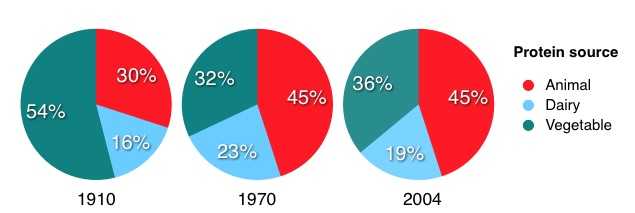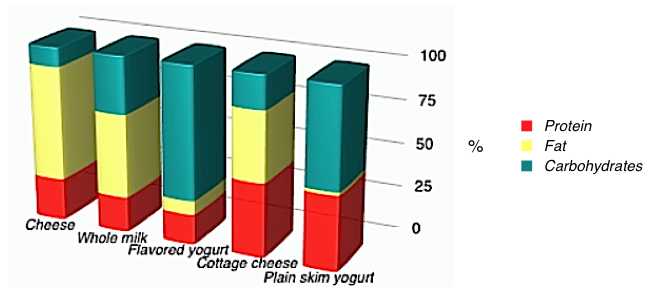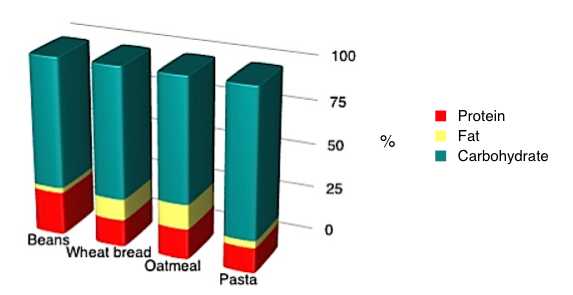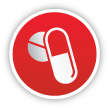What is protein and why do we need it?
Proteins are the building blocks of the body.

Protein is made up of amino acids. They are the body’s only source of nitrogen. There are 20 common amino acids, 8 of which are considered essential because they must be supplied in the diet. The liver can make the non-essential amino acids from other amino acids.
The body has no storage organ for protein, so it has to be supplied daily.
Muscles are thought to be storage organs for protein, however they are necessary for body structure and function. They can supply protein to the body by breaking down (which occurs in starvation, and all calorie deficient diets). However when muscle tissue breaks down, the body is weakened.
Where do we get protein?
In the ideal diet, protein supplies only 12% of the total calories. Protein is available from many food sources, not just meat and animal products.
During the first decade of the last century, when the USDA began analyzing the diets of Americans it was found that meat, fish and poultry supplied only 30% of the total calories consumed. Dairy products supplied 16% and vegetable, fruits, nuts, beans and grains supplied 54%. By 1970, 45% of protein came from meat and dairy had risen to 23%. Note the change in 2004 where protein from vegetables has increased and that from dairy is decreasing back to the 1910 level.
Animal and dairy products now comprise almost 63% of our total protein.
Nutritionists believe that a balanced diet should derive only about 33% of its protein from animal sources and 67% from plants.
There are many reasons for this recommendation:
There is almost no digestible fiber in animal products.
The protein in meat commonly is delivered with an equal percentage of saturated fat. In 3.5 oz. (100 g.) of broiled ground beef, 33% calories will come from protein and 63% will come from fat. In a chicken breast without skin, 62% calories come from protein and 36% from fat. In baked haddock, 8% of calories come from protein and 8% from fat. Pork ribs deliver 26% protein and 72% fat:
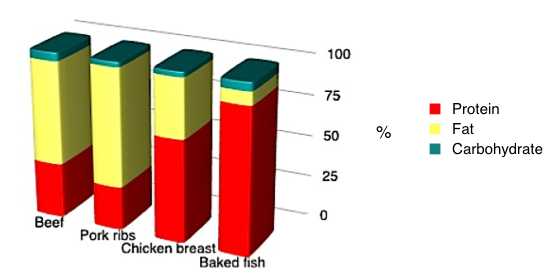 Fish muscle has much less fat than animal muscle, and contains the healthier omega-3 fatty acids.
Fish muscle has much less fat than animal muscle, and contains the healthier omega-3 fatty acids.
Fish contains the same amount of cholesterol as animal sources.
Dairy products are even higher in fat with cheese deriving 24% of its calories from protein, 66% from fat and 10% carbohydrate. Whole milk is 20% protein, 48% fat and 32% carbohydrate. Regular cottage cheese is 42% protein, 40% fat and 18% carbohydrate. Flavored yogurt is 17% protein, 8% fat and 75% carbohydrate. Skim yogurt has more protein and less sugar than flavored:
Plant foods have a different composition profile, and are much higher in complex carbohydrates. Beans are 24% protein, 3% fat and 73% carbohydrate. Store bought whole wheat bread is 15% protein, 12% fat and 73% carbohydrate. Oatmeal is 17% protein, 14% fat and 69% carbohydrate. Plain pasta is 14%, 4% fat and 82% carbohydrates.
Note that the vegetable sources would satisfy the 12% protein composition recommended by the USDA, and would be considered very low fat.
Is there any problem with eating too much protein?
Because there is no protein storage organ, excess protein as nitrogen will be excreted by the kidneys.
Protein is the most expensive component of our diet. It is a waste of money to just excrete out the excess. We also should become aware of the environmental cost of raising animal protein.
The liver converts the nitrogen into ammonia and urea, and the kidneys excrete these toxic by-products. This puts an immense strain on both organs. It’s important to note that individuals with liver or kidney problems are placed on low protein diets.
The kidneys must excrete a lot of water to rid the body of the toxic wastes of protein metabolism. This helps to explain the rapid weight loss associated with high protein, low carbohydrate diets. Most of the weight is water that the kidneys use to dilute the nitrogen waste!
How much protein do we need?
The experts are still not sure exactly how much protein is necessary. Much of the original work was done using laboratory rats, but because rats grow so much faster than humans, they require much more protein. For example the breast milk of rats contains 20% protein while that of humans contains 7%. When humans were fed a low protein diet, including eating only rice for 60 days, they were still getting enough protein to maintain positive nitrogen balance.
The present RDA for proteins is actually 45% greater than what is needed, because not all protein sources are equivalent. Dieticians base their diets on these recommendations, so the government has chosen to overestimate the needs for protein to insure adequate protein nutrition.
Protein requirements change throughout life.
They are greatest in infancy when the growth rate is the fastest. By the age of 18, the protein needs drop to their lowest point, rising again in old age.
To calculate your protein requirement in grams, find the factor that applies to you and multiply it by your weight in pounds:
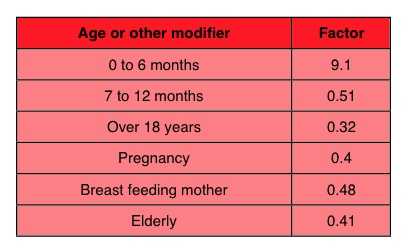 E.g. 40 year old male 165 lbs. X 0.32 grams per pound = 52.8 grams
E.g. 40 year old male 165 lbs. X 0.32 grams per pound = 52.8 grams
